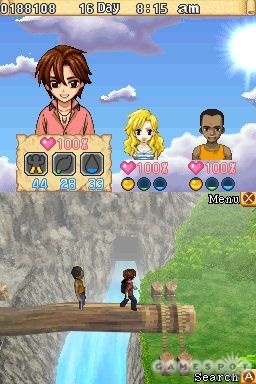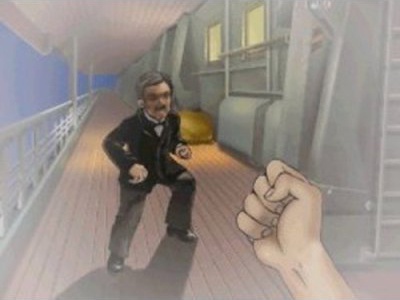Lost in Blue 3 is the third in Konami's survival adventure series and maintains the franchise's traditional premise, casting you as either a male or female character stranded on an island after the mysterious sinking of a cruise ship. After you've washed ashore and regained a few memories you'll run into your partner, another miraculous survivor, at which point you must keep each other alive until you're rescued or manage to escape. For perhaps the series' sole plot twist, the game includes two additional characters you'll run into as the storyline progresses, and all three partners offer their own unique services that'll aid you in discovering a way off this tropical deathtrap.

Just as in previous Lost in Blue titles, the bulk of the gameplay tasks you with keeping a steady eye on your characters' four status gauges, measuring stamina, food, water, and health. Each gauge drains over time and has a particular effect when it reaches zero, either reducing you to a walk during exploration, keeping you awake so you can't sleep to refill your stamina gauge, or preventing you from eating dry food to raise your food bar; the steady reduction of one or several bars costs you health points, and a character whose HP reaches zero dies a slow and tragic death. Because it would be just plain cruel to let the other characters escape after the death of a comrade, it's game over, so your immediate survival depends entirely on filling these status gauges.
To this end Lost in Blue 3 boasts a heavy emphasis on micromanagement, requiring you to scavenge for food, trek to the nearest freshwater stream for water, and collect a full host of other items that make island life a little easier. After you've gathered several items you can forge tools that'll allow you to engage in simple minigames, including blowing into the mic to start a fire or tapping fish to spear them. You can also grill by drawing circles on food items to flip them over, cut up fresh fruit for salads by "slicing" them with the stylus, or even milk a goat if you're in the mood. While most of the minigames provide a refreshing break from the monotony of downing gallons of water and stuffing your face with coconuts, some of them--in particular grilling and furniture building--are very finicky when it comes to the stylus. If you're not drawing circles directly on the center of each delicious unit of sustenance or placing pieces of wood at exactly the right location, with the "aesthetic" side facing upward, you'll burn your grub or spend forever trying to nail two sticks together.
Island exploration is another key element that adds a touch of variety and excitement to the gameplay. The island is dense enough to require several real-time hours to explore and contains all sorts of treats to discover, like shipwrecks, new types of food, crazed crocodiles, and even a few deer if your stomach is rumbling for Bambi. While it is fun to stumble upon new areas, quite often you'll have no idea of what you're doing, as the game gives you few instructions; usually you just wander around until you find something to discuss with a partner back at the base, which amounts to a lot of backtracking. Getting hints from partner characters is also frustrating due to the discussion menu, which conveniently kicks you from the dialogue screen after you mention a topic, like "build me a table." If you need multiple things from a character then you're forced to waste time toggling through requests. Furthermore, even if you have the appropriate partner with you on the field during an important event that you want to discuss, you can't converse on the spot--you have to drag him back to the cave before he'll acknowledge what he just saw. If you're feeling lonely you can re-experience Lost in Blue with a friend via a Download Play option or a cooking battle, but after you complete the main storyline your only incentives to revisit the island include playing another character or trying your hand at survival challenge, which tests how long you can last on the island before pitifully dying alone.
Though the best parts of the game involve exploring and playing through the minigames to gather materials, both have huge caveats: You can't explore for very long because your buddies at the cave wither away and die without your constant supervision, while spearing fish, shaking trees, and cooking a thousand meals gets old and tiresome fast. All you really want to do is advance and find out what happened on the cruise ship and, of course, if the group ever gets off the island, but you're forced to babysit idiots who will kill themselves without your undying love and support.
But finicky minigames and poor dialogue menus are the least of your worries, as filling the status gauges will quickly vex and bore you. It's just too easy for characters to die; for example, even if all three of your partners are starving at the base they will wait for you to return with food instead of foraging on their own, sometimes unto their own demise. Dehydrated characters, especially those standing next to a conveniently placed oil drum full of vast quantities of fresh water, won't actually drink it until you leave the cave, as if they're waiting on you to fetch it for them.

Lost in Blue 3's greatest fault, however, lies not in its merciless backtracking or tight micromanagement control but in its vast amount of recycled material. Most of its minigames, food items, and menu graphics are stripped from its predecessors, and the game retains the franchise's fixed camera and bland visuals culminating in a poorly textured 3D island populated with 2D trees. The sad reality is that series veterans experienced all this franchise has to offer two games ago.